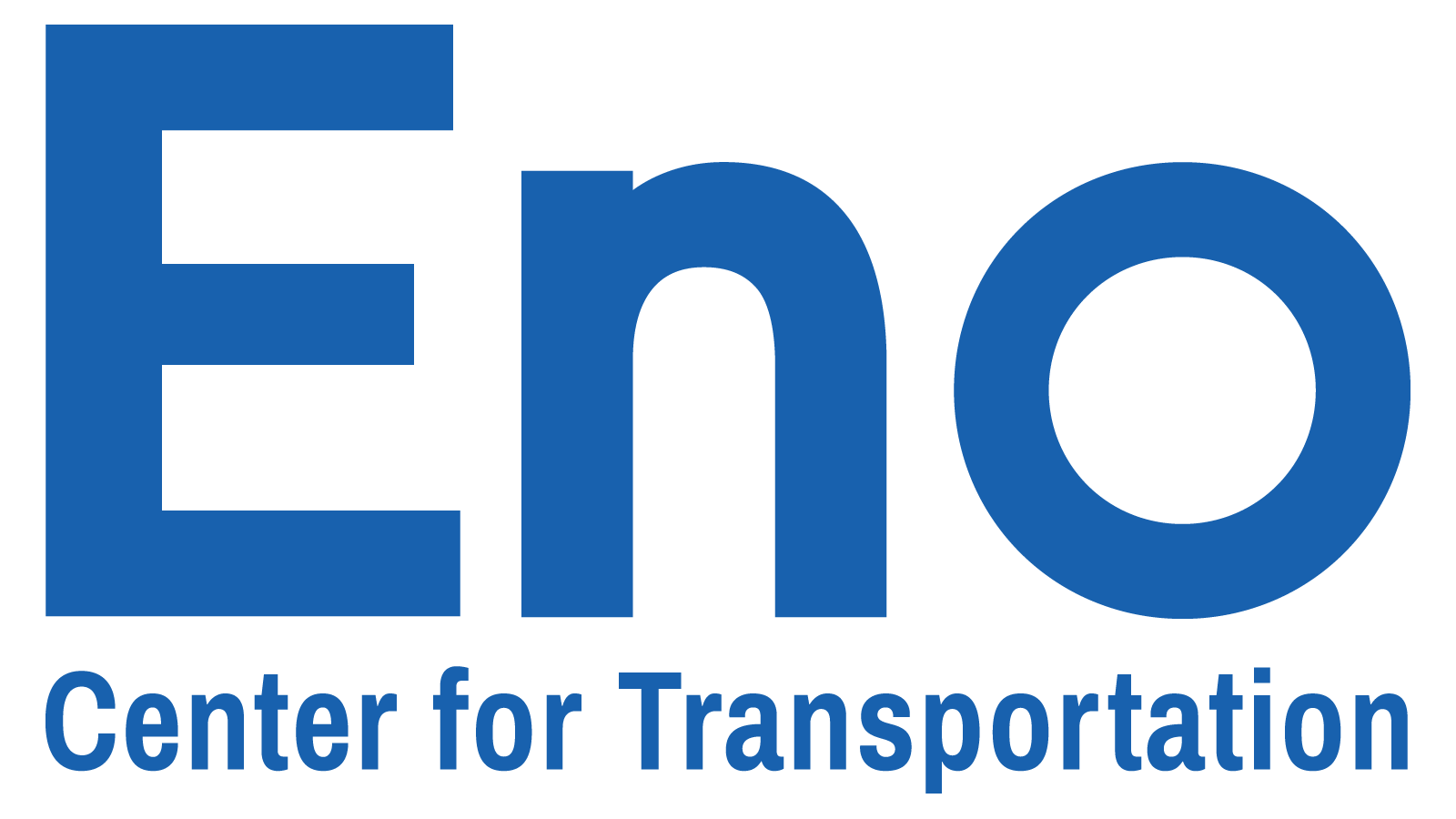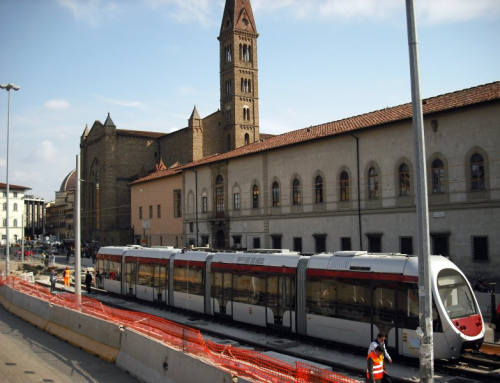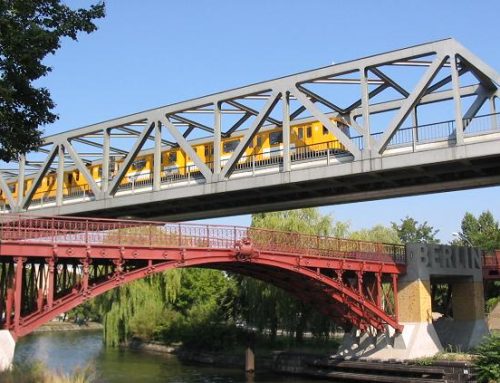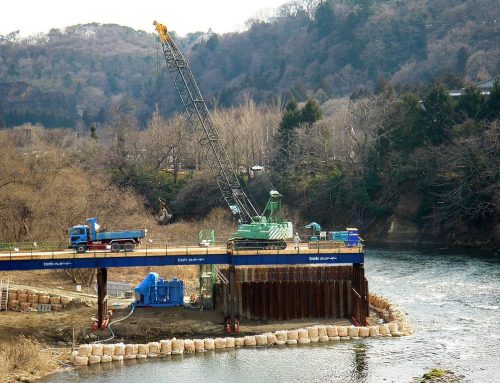Canada
Canadian regions have delivered 12 rail transit projects over the last two decades, including tunneled extensions in Toronto and new light rail lines in Vancouver. Canadian construction costs for subways are generally higher than those in other democratic countries but are still lower than the average in the United States on a per-mile basis. At-grade construction costs are similar to those of the U.S., ranging from as low as $71 million per mile in Waterloo to $350 million per mile in Edmonton.
Transit projects are funded through a combination of sources from the federal government, provincial governments, and municipalities. Unlike many countries where environmental and other forms of regulation come from the national level, the Canadian provinces are largely in charge of environmental and other reviews. Ontario in particular has taken a unique approach by developing a special process for transit projects, which are subject to their own streamlined environmental reviews.
Table of Contents
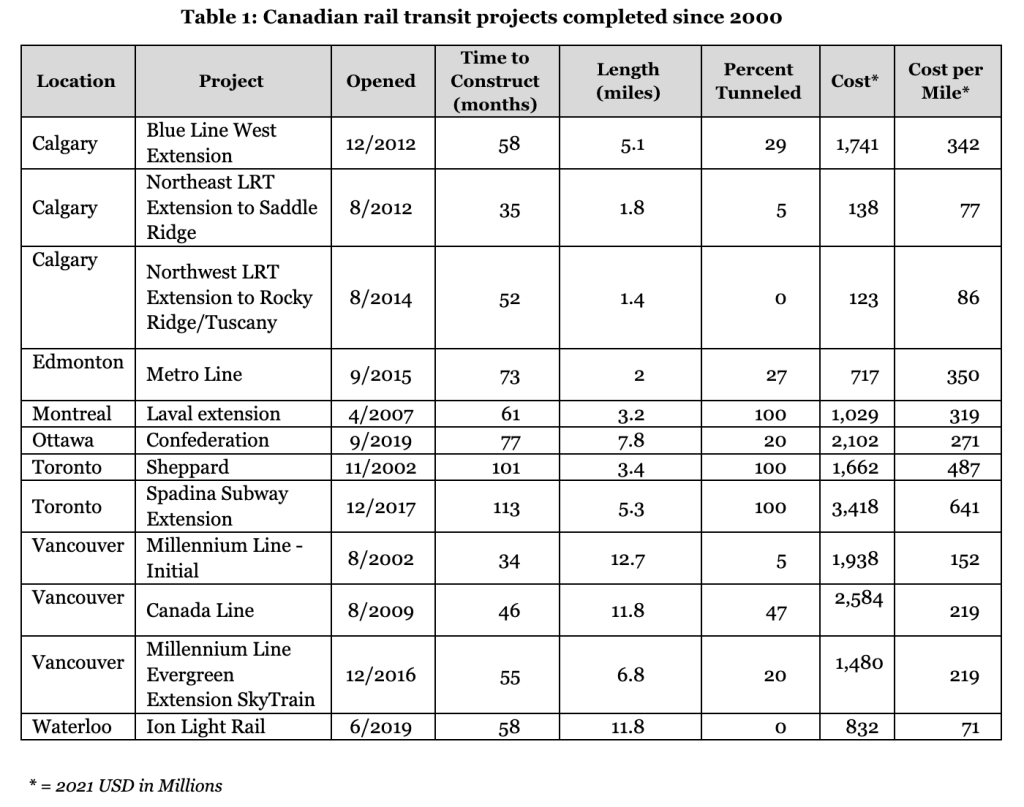
Governance
Canada is a federation and consists of 10 provinces and three territories. It has a parliamentary system within a constitutional monarchy that serves as the base of the executive, legislative, and judicial branches of government. Except for Quebec, where the French civil law system is used, common law applies in most of Canada. Research shows that common or civil law does not play a significant role in reducing transit project timelines and costs, but the only project in Quebec happens to be the least expensive and fastest of the three tunneled projects in Canada. It is unclear whether the province’s legal structure affected this outcome or if other factors made the project in Montreal less expensive and faster to build.
The Canadian federal government oversees international and inter-province transportation, while urban transportation is entirely under provincial jurisdiction. In some cases, municipalities are also responsible for local transit systems when given authority from the provincial governments.
The federal government has a very limited role in the planning, assessment, and approval of public transportation projects, which are almost exclusively handled at the provincial level, though the federal government does serve as a major funder for transit projects. The federal government has historically funded up to one-third of project costs, but over the last decade has funded up to half, in part due to Parliament’s climate-related priorities.
Transport Canada, a federal ministry, is responsible for monitoring and updating laws and regulations that govern transportation and conducting inspections of transportation facilities, operations, and equipment across the country. Transport Canada funds relatively small projects related to transportation safety, technology, and sustainability improvements.
Infrastructure Canada is the federal agency responsible for developing, funding, and financing infrastructure projects across the country. It allocates funding through several funding programs, such as the Investing in Canada Infrastructure Program (ICIP), which is part of the agency’s 2016 5-year Investing in Canada Plan. The ICIP includes nearly $10 billion in funding for public transit programs distributed through bilateral agreements with provinces and territories. Infrastructure Canada also provides financing through public-private partnerships (P3s) and agreements with provinces, territories, and municipalities.
In 2017, Canada established the Canada Infrastructure Bank, a state-owned enterprise independent of Infrastructure Canada tasked with leveraging $28 billion in federal financing to attract private involvement, including transportation P3s, in revenue-generating infrastructure projects in the public interest. The Bank finances projects across several sectors: clean power, toll roads, public transportation, trade and transportation, and broadband. The Bank supports private and public financing for six public transportation projects currently underway. These include the Réseau Express Métropolitain (REM) P3 project, a 41-mile automated light rail network in Montreal, as well as an expansion of Ontario’s GO commuter rail system (whose operations are competitively bid). The other projects include a new REM airport station in Montreal and funding for zero-emission buses in several cities.
Provinces are governed by an elected parliament, from which the premier – the province’s chief executive – is chosen. Under the constitution, Canada’s 10 provinces are responsible for much of the day-to-day governance of transportation, health, and education, among other key public services. Ultimate decision-making power to approve or reject projects lies with the provinces, given their funding role.
The provincial governments have the power to determine the structure and authorities of municipalities, as well as regional transportation authorities or agencies. Most major metropolitan areas in Canada are completely within province boundaries, except for the Ottawa region straddling Ontario and Quebec. Rail transit planning and design happens at the provincial level given that their jurisdiction includes the entire region and crosses municipal boundaries.
The structure of public transit agencies varies by province. In the Toronto region, transit planning is the responsibility of Metrolinx, the region’s planning and fare integration body. Metrolinx was created by the province of Ontario in 2006 to develop Toronto’s first-ever regional transportation plan, and to provide better regional integration of transit planning and decision-making. The board of Metrolinx consists of 15 citizen members recommended by the Ontario Minister of Transportation and approved by the province. Until 2009, the Metrolinx board consisted primarily of mayors and regional elected officials. The TTC board consists of 10 members appointed by the Toronto City Council, of whom four are members of the public and six are city councilors.
Most transit operations are carried out by independent public sector providers. The Toronto Transit Commission (TTC), owned by the City of Toronto, is the largest operator in the region and manages most subways and urban bus lines in the city. Smaller operators like York Region Transit and Mississauga Transit operate local bus systems. Metrolinx also operates the region’s commuter rail system (GO Train).
In Vancouver, located in the province of British Columbia, transit is governed by Translink, an entity created by the province in 1998 as a response to local officials seeking more control over public transit. Prior to the creation of TransLink, transit planning and delivery was carried out by BC Transit, a provincial corporation. BC Transit continues to carry out transit planning and delivery across the province outside of the Greater Vancouver region. Unlike Metrolinx, Translink is not a provincial agency, but rather a regional authority. It is governed by a corporate board of directors consisting of non-political, unelected experts, as well as a council of mayors from each of the 21 surrounding municipalities.
In Montreal, transit planning is under the jurisdiction of the Metropolitan Regional Transit Authority (ARTM), a provincial agency created by Quebec in 2017 to replace the Agence Métropolitaine de Transport (AMT) and integrate road and transit planning. The suburban bus and commuter rail operating segment of AMT was spun off into an operating agency called Exo (or RTM). The Sociéte de Transport de Montreal (STM) is the operating agency responsible for Montreal’s buses and subway system. Other operators in the region include the Société de transport de Laval (STL), which operates bus routes in the city of Laval north of Montreal, and the Réseau de transport de Longueuil (RTL), which operates bus routes in Montreal’s South Shore. Both STL and RTL report to ARTM.
Overall, transit agency structures for the country’s largest rapid transit systems range from full provincial control in Toronto to regional governance structures in Vancouver. Rapid transit systems in Ottawa, Edmonton, and Calgary are all municipally owned.
Project planning and regulation
Transit planning in Canada is carried out by the primary transit agency or authority in each region in consultation with other stakeholders, including municipalities and provinces as described above. A notable theme across regions in Canada is the extent to which multiple actors are involved in proposing, modifying, and, in some cases, cancelling transit plans.
In Montreal, ARTM is responsible for regional transit planning, and is also helping coordinate integration of the existing transit system with REM, a new 42-mile automated light rail system planned, financed, and delivered by CDPQ Infra, a subsidiary of Quebec’s pension fund, the Caisse de Dépôt et placement du Québec. This arrangement grew out of a 2015 agreement between the provincial government and the Caisse to allow the pension fund to finance, manage, and deliver major infrastructure projects. The Caisse is also a major investor in the construction and operation of Vancouver’s Canada Line, a design-build-finance-operate-maintain P3 project.
The REM project was not formally planned or proposed by the city or any of the regional transportation authorities. As a result, it has come under scrutiny from transit advocates and officials in the region who have criticized the REM’s lack of prior integration and coordination with the region’s existing commuter and subway operations, and accuse CDPQ of taking over transit planning from the newly created ARTM. CDPQ officials, however, have noted that the fund has the potential to deliver the REM faster than other public sector agencies — under 10 years between project proposal and completion, if the REM is opened as planned.
The debate surrounding the REM reflects concerns over political interference, unpredictability, and excessive actors in transit planning that interviewees and past reporting have indicated is the case in other regions. In Toronto, projects are often proposed and cancelled (and re-proposed again) based on changes in political leadership, even for projects that were already planned or under construction. These politically motivated scope changes and cancellations have resulted in nearly $340 million in sunk costs for Metrolinx, according to Ontario’s Auditor General.
Regulation and permitting of transit projects is handled by provincial governments, though the federal government oversees safety regulations. Provinces also conduct environmental reviews for transit projects, each with their own requirements and standards.
In Ontario, transit projects are subject to their own streamlined environmental review process called the Transit Project Assessment Process (TPAP). The TPAP is overseen by the Ontario Ministry of Environment, Conservation and Parks and is a largely self-directed process for project sponsors to analyze potential impacts and solicit public input within specified time windows. Unlike for highway and other infrastructure projects in the province, TPAP does not require an alternatives analysis and does not mandate any specific analyses, though regulatory agencies can request specific studies (i.e. for noise, vibrations, or cultural heritage impacts).
In 2020, the province further streamlined the permitting and review process for the Ontario Line, Eglinton West LRT, Yonge North, and Scarborough extension projects through the Building Transit Faster Act. Among its provisions are the elimination of non-binding “hearings of necessity” previously required for land acquisition, as well as new powers for Metrolinx to order utility relocations, enter property within transit corridors to remove obstacles without owners’ consent (with sufficient notice ), and to close streets or access city infrastructure if municipalities cannot reach an agreement with Metrolinx.
The province instituted additional streamlining efforts for the Ontario Line to allow utility relocation, station construction, and other early works to be carried out before completion of environmental reviews. These regulations created a new class of narrow assessments called Early Works Reports for these early construction activities to evaluate their impact. It is unclear how much time these streamlining efforts save, but interviewees noted exemption from certain steps has undoubtedly sped up the process.
Federal law does require public consultation for transit projects for provincial environmental review processes. Interviewees generally noted that the public engagement process is not as prone to litigation and contention as in the United States, though the intensity and rigor of community engagement can vary across projects and provinces. Some interviewees noted that public consultation can sometimes offer few opportunities to influence decision-making, particularly when there is strong political pressure to build a project.
Project funding
Canadian projects are funded by a combination of federal, provincial, and local government contributions. Historically, each level of government contributed roughly one-third of funding to transit capital project costs. However, the federal government is now increasing its contribution, driven in part by increasing emphasis on environmental sustainability initiatives. Most recently in May 2021, the Canadian federal government committed to funding up to 40 percent of capital costs for four transit projects in Ontario.
Transit funding is not subject to a clearly defined process in most provinces. Similarly, there is no formal process at the federal level to evaluate and decide which projects receive funding like the United States’ CIG grant process, for example. In fact, a 2011 report found that Canada was the only G7 country without dedicated, long-term federal funding for public transit agencies. Rather, federal funding decisions are made on a one-off basis for individual projects via negotiation and discussions directly with provinces and municipalities.
Canadian municipalities are limited in their ability to levy taxes and rely mostly on property taxes and fees for infrastructure funding, which has also been a factor in increased support from the federal government.
Project construction
Transit projects in Canada are often delivered by the primary agency or transportation authority in major cities, though there have been numerous changes in recent years. As discussed above, a new subsidiary of Quebec’s pension fund, Caisse, has taken on a significant project delivery role for several ongoing transit projects in Montreal. In Toronto, responsibility for project delivery was transferred from municipally controlled TTC to the provincial agency Metrolinx in 2015 amid cost overruns on the Spadina Subway Extension. Metrolinx is responsible for delivering the next wave of rail capital projects, including the Line 5 Eglinton, the Ontario Line, the Line 1 Yonge subway extension into Richmond Hill in the York Region, and the Line 2 Bloor–Danforth extension into Scarborough. However, Infrastructure Ontario, a provincial organization that leads P3 procurements, is delivering two light rail projects, the Eglinton and Finch West lines, using a design-build-finance-operate-maintain approach.
Takeaways
Canada has constructed an impressive amount of new rail transit in the past 20 years and is currently building significantly more. Despite this, interviewees characterized the planning and decision-making approach as inconsistent and highly political, contributing to a high degree of uncertainty over the validity and permanence of any formal plans announced by transit agencies or province. There is often no guarantee that reports or plans will be acted upon, and the ultimate responsibility for approving projects lies with the province.
In an effort to overcome this, some project sponsors have opted to use a P3 procurement method often run by an entity that is not the primary transit operator. P3s are currently being used in Toronto through Infrastructure Ontario and on the REM projects in Montreal through the CDPQ. A P3 was also used to deliver Vancouver’s Canada Line at the direction of the provincial government, which agreed to fund the project only if it was delivered as a P3. It was unclear from this analysis whether that approach has yielded measurable cost or timeline improvements.
Where Canada might provide some useful lessons is in its approach to environmental review, particularly in Ontario. Exempting or modifying rules for transit projects appears to have streamlined the pre-construction phase of the work and possibly reduced construction barriers. However, interviewees expressed caution to ensure that community engagement is not dismissed when certain environmental rules are exempted or streamlined for transit projects.
